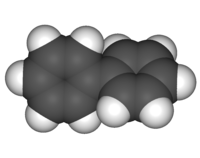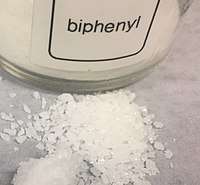Biphenyl
Biphenyl (also known as diphenyl, phenylbenzene, 1,1′-biphenyl, lemonene or BP) is an organic compound that forms colorless crystals. Particularly in older literature, compounds containing the functional group consisting of biphenyl less one hydrogen (the site at which it is attached) may use the prefixes xenyl or diphenylyl.[4]
 | |
 | |
 | |
| Names | |
|---|---|
| Preferred IUPAC name
1,1'-Biphenyl | |
| Other names
Biphenyl Phenyl benzene | |
| Identifiers | |
3D model (JSmol) |
|
| 3DMet | |
| 1634058 | |
| ChEBI | |
| ChEMBL | |
| ChemSpider | |
| ECHA InfoCard | 100.001.967 |
| EC Number |
|
| E number | E230 (preservatives) |
| 3808 | |
| KEGG | |
PubChem CID |
|
| RTECS number |
|
| UNII | |
| UN number | 3077 |
CompTox Dashboard (EPA) |
|
| |
| |
| Properties | |
| C12H10 | |
| Molar mass | 154.212 g·mol−1 |
| Appearance | Colorless to pale-yellow crystals |
| Odor | pleasant[1] |
| Density | 1.04 g/cm3[2] |
| Melting point | 69.2 °C (156.6 °F; 342.3 K)[2] |
| Boiling point | 255 °C (491 °F; 528 K)[2] |
| 4.45 mg/L[2] | |
| Vapor pressure | 0.005 mmHg (20°C)[1] |
| −103.25·10−6 cm3/mol | |
| Hazards | |
| GHS pictograms |   |
| GHS Signal word | Warning |
GHS hazard statements |
H315, H319, H335, H400, H410 |
| P261, P264, P271, P273, P280, P302+352, P304+340, P305+351+338, P312, P321, P332+313, P337+313, P362, P391, P403+233, P405, P501 | |
| NFPA 704 (fire diamond) | |
| Flash point | 113 °C (235 °F; 386 K)[2] |
| 540 °C (1,004 °F; 813 K)[2] | |
| Explosive limits | 0.6–5.8%[1] |
| Lethal dose or concentration (LD, LC): | |
LD50 (median dose) |
2400 mg/kg (oral, rabbit) 3280 mg/kg (oral, rat) 1900 mg/kg (oral, mouse) 2400 mg/kg (oral, rat)[3] |
| NIOSH (US health exposure limits): | |
PEL (Permissible) |
TWA 1 mg/m3 (0.2 ppm)[1] |
REL (Recommended) |
TWA 1 mg/m3 (0.2 ppm)[1] |
IDLH (Immediate danger) |
100 mg/m3[1] |
Except where otherwise noted, data are given for materials in their standard state (at 25 °C [77 °F], 100 kPa). | |
| Infobox references | |
It has a distinctively pleasant smell. Biphenyl is an aromatic hydrocarbon with a molecular formula (C6H5)2. It is notable as a starting material for the production of polychlorinated biphenyls (PCBs), which were once widely used as dielectric fluids and heat transfer agents.
Biphenyl is also an intermediate for the production of a host of other organic compounds such as emulsifiers, optical brighteners, crop protection products, and plastics. Biphenyl is insoluble in water, but soluble in typical organic solvents. The biphenyl molecule consists of two connected phenyl rings.
Properties and occurrence
Biphenyl occurs naturally in coal tar, crude oil, and natural gas and can be isolated from these sources via distillation.[5] It is produced industrially as a byproduct of the dealkylation of toluene to produce benzene:
- C6H5CH3 + C6H6 → C6H5−C6H5 + CH4
The other principal route is by the oxidative dehydrogenation of benzene:
- 2 C6H6 + 1⁄2 O2 → C6H5−C6H5 + H2O
Annually 40,000,000 kg are produced by these routes.[6]
In the laboratory, biphenyl can also be synthesized by treating phenylmagnesium bromide with copper(II) salts.
Reactions and uses
Lacking functional groups, biphenyl is fairly non-reactive, which is the basis of its main application. In the laboratory, biphenyl is mainly used as a heat transfer agent as a eutectic mixture with diphenyl ether. This mixture is stable to 400 °C.
Biphenyl does undergo sulfonation followed by base hydrolysis produces p-hydroxybiphenyl and p,p′-dihydroxybiphenyl, which are useful fungicides. In another substitution reactions, it undergoes halogenation. Polychlorinated biphenyls were once popular pesticides.[6]
Biphenyl is reduced to the radical anion with lithium, a versatile reducing agent.[7] It offers some advantages relative to the related lithium naphthenide.[8] Related to Li/biphenyl is the derivative with two tert-butyl groups on the biphenyl.[9]
Stereochemistry
Rotation about the single bond in biphenyl, and especially its ortho-substituted derivatives, is sterically hindered. For this reason, some substituted biphenyls show atropisomerism; that is, the individual C2-symmetric-isomers are optically stable. Some derivatives, as well as related molecules such as BINAP, find application as ligands in asymmetric synthesis. In the case of unsubstituted biphenyl, the equilibrium torsional angle is 44.4° and the torsional barriers are quite small, 6.0 kJ/mol at 0° and 6.5 kJ/mol at 90°.[10] Adding ortho substituents greatly increases the barrier: in the case of the 2,2'-dimethyl derivative, the barrier is 17.4 kcal/mol (72.8 kJ/mol).[11]
Biological aspects
Biphenyl prevents the growth of molds and fungus, and is therefore used as a preservative (E230, in combination with E231, E232 and E233), particularly in the preservation of citrus fruits during transportation. It is no longer approved as a food additive in the European Union.
It is mildly toxic, but can be degraded biologically by conversion into nontoxic compounds. Some bacteria are able to hydroxylate biphenyl and its polychlorinated biphenyls (PCBs).[12]
It is part of the active group in the antibiotic oritavancin.
Biphenyl compounds
Substituted biphenyls have many uses. They are prepared by various coupling reactions including the Suzuki-Miyaura reaction and the Ullmann reaction. Polychlorinated biphenyls were once used as cooling and insulating fluids and polybrominated biphenyls are flame retardants. The biphenyl motif also appears in drugs such as diflunisal and telmisartan. The abbreviation E7 stands for a liquid crystal mixture consisting of several cyanobiphenyls with long aliphatic tails used commercially in liquid crystal displays (5CB, 7CB, 8OCB and 5CT[13]). A variety of benzidine derivatives are used in dyes and polymers. Research into biphenyl liquid crystal candidates mainly focuses on molecules with highly polar heads (for example cyano or halide groups) and aliphatic tails.
See also
- Naphthalene, where the rings are fused
- Terphenyl, three ringed analog
- Bithiophene
Notes
- NIOSH Pocket Guide to Chemical Hazards. "#0239". National Institute for Occupational Safety and Health (NIOSH).
- Record in the GESTIS Substance Database of the Institute for Occupational Safety and Health
- "Diphenyl". Immediately Dangerous to Life or Health Concentrations (IDLH). National Institute for Occupational Safety and Health (NIOSH). 4 December 2014. Retrieved 17 March 2015.
- "Beilsteins Handbuch der organischen Chemie, Volume 5".
- Adams, N. G., and D. M. Richardson, 1953. Isolation and Identification of Biphenyls from West Edmond Crude Oil. Analytical Chemistry 25 (7): 1073-1074
- Karl Griesbaum, Arno Behr, Dieter Biedenkapp, Heinz-Werner Voges, Dorothea Garbe, Christian Paetz, Gerd Collin, Dieter Mayer, Hartmut Höke "Hydrocarbons" in Ullmann's Encyclopedia of Industrial Chemistry 2002 Wiley-VCH, Weinheim. doi:10.1002/14356007.a13_227
- Akira Yanagisawa, Katsutaka Yasue, Hisashi Yamamoto (1997). "Regio- and Stereoselective Carboxylation of Allylic Barium Reagents: (E)-4,8-dimethyl-3,7-nonadienoic Acid". Org. Synth. 74: 178. doi:10.15227/orgsyn.074.0178.CS1 maint: uses authors parameter (link)
- Reuben D. Rieke, Tse-Chong Wu, Loretta I. Rieke (1995). "Highly Reactive Calcium for the Preparation of Organocalcium Reagents: 1-Adamantyl Calcium Halides and Their Addition to Ketones: 1-(1-Adamantyl)cyclohexanol". Org. Synth. 72: 147. doi:10.15227/orgsyn.072.0147.CS1 maint: uses authors parameter (link)
- Boguslaw Mudryk, Theodore Cohen (1995). "1,3-Diols from Lithium β-Lithioalkoxides Generated by The Reductive Lithiation of Epoxides: 2,5-Dimethyl-2,4-hexanediol". Org. Synth. 72: 173. doi:10.15227/orgsyn.072.0173.CS1 maint: uses authors parameter (link)
- Mikael P. Johansson and Jeppe Olsen (2008). "Torsional Barriers and Equilibrium Angle of Biphenyl: Reconciling Theory with Experiment". J. Chem. Theory Comput. 4 (9): 1460. doi:10.1021/ct800182e.
- B. Testa (1982). "The geometry of molecules: basic principles and nomenclatures". In Christoph Tamm (ed.). Stereochemistry. Elsevier. p. 18.
- "Biphenyl degradation - Streptomyces coelicolor, at GenomeNet Database". genome.jp.
- Mouquinho, Ana; Saavedra, Mara; Maiau, Alexandre; Petrova, Krasimira; Barros, M. Teresa; Figueirinhas, J. L.; Sotomayor, João (30 June 2011). "Films Based on New Methacrylate Monomers: Synthesis, Characterisation and Electro-Optical Properties". Molecular Crystals and Liquid Crystals. 542 (1): 132/[654]–140/[662]. doi:10.1080/15421406.2011.570154.
References
- "Isolation and Identification of Biphenyls from West Edmond Crude Oil". N. G. Adams and D. M. Richardson. Analytical Chemistry 1953 25 (7), 1073–1074.
- Biphenyl (1,1-Biphenyl). Wiley/VCH, Weinheim (1991), ISBN 3-527-28277-7.
